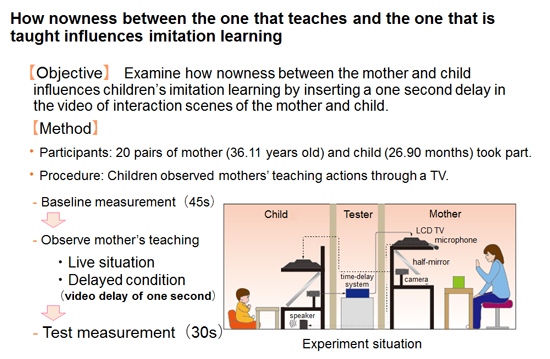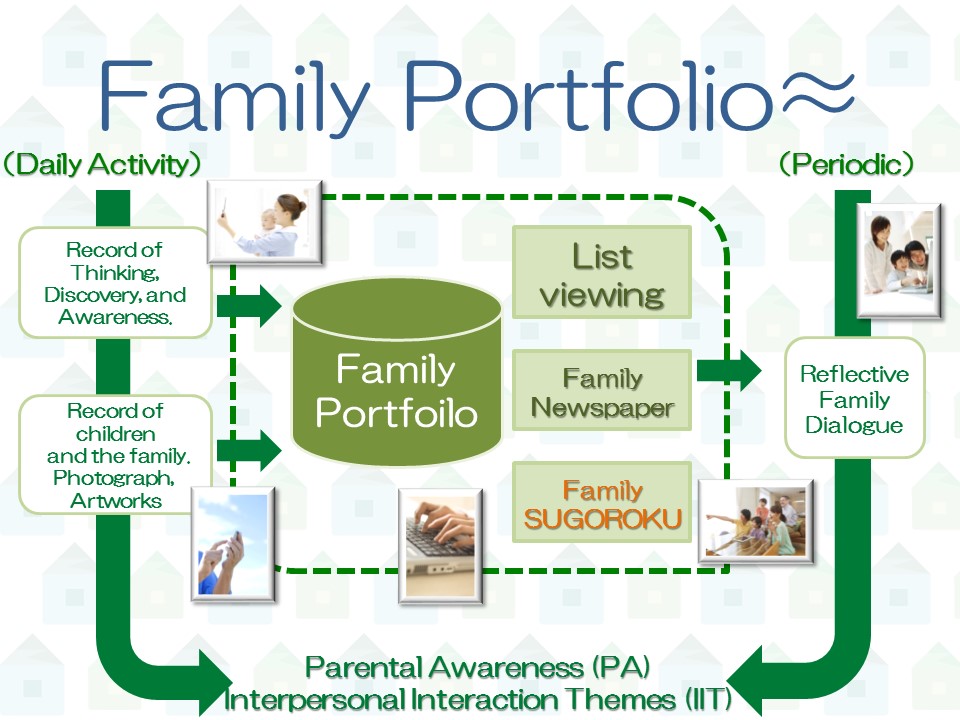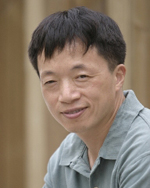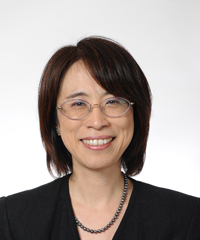Presented at the Second International Conference of Child Research Network Asia (CRNA) held in Tokyo, Japan, March 17-18, 2018.
Moderator: Yeh Hsueh (Associate Professor, University of Memphis, USA)
Presenters: Kazuo Hiraki (Professor, The University of Tokyo, Japan), Tomomi Sato (Associate Professor, Aichi Shukutoku University, Japan), Hiroko Sakaue (Managing Director, NHK Educational Corporation, Japan)
Hsueh: Because the theme of this concurrent session is particularly complex and divergent, I expect a wide array of opinions to come forth into our discussion following three panelists' presentations. So, before we get into that engaging discussion, let's welcome our first speaker, Professor Hiraki, to present his research to us.
Are Robots or AI Systems Able to Teach Human Beings? (Kazuo Hiraki)
Hiraki: I am currently involved in scientific research surrounding the psychology, behavior, and brain development in infants, also known as "baby science." In today's presentation, I would like to introduce several studies I have conducted while considering whether robots or AI systems can successfully nurture social and emotional skills. To put it in other words, can robots or AI systems teach human beings?
In order to properly understand how social and emotional skills are developed, we must first comprehend how babies perceive the people they are in contact with, and also how they process information provided by these people. There are studies being conducted on this very matter in various places around the world, utilizing a variety of methods. Today, I would like to talk about the "Methodology of developmental cognitive science."
I will introduce you to our research carried out under the cooperation of children from two to two and a half years old and their mothers. We placed a mother and a child in separate rooms and asked the mother to teach how to play with toys her child is unfamiliar with via a communication system like a videophone. In one of the situations the interaction was carried out in real time and the other had a delay of one second in communication. You may have seen in TV news programs, a situation where there is a lag between the communications of a reporter in a remote location and the anchor in the broadcasting studio. We deliberately created the same situation in this research. The results showed that the child who was taught in real time was able to understand much more easily how to play with the toys. The slightest gap of only a second has a profound effect on imitative learning. The "nowness" or the fact that "I am teaching you now," and the "responsiveness" or the fact that the interlocutor responds to you immediately seem to be important factors for teaching or being taught (Fig. 1).

Figure 1
As a result of this research, I have been focusing my energies into a "Pedagogical Machine," a study set up to distinguish how humans and robots diverge in their behavior. Allow me to introduce several particular examples from this work.
We are conducting a research project involving the use of a robot that reads "The Three Little Pigs" in French, like a kami-shibai [a traditional Japanese storytelling method using storyboards and acting] on a TV display to Japanese preschool students. The children listen intently to the robot perform the kami-shibai of "The Three Little Pigs" in French; after hearing the story a number of times, they are then able to recognize certain French words from the reading. For example, when having two French words spoken to them and then being asked which word meant "pig," the children are able to provide the correct answer with an accuracy that strongly suggests more than mere coincidence.
In a research project aiming to comprehend how a parent and child interact with each other in daily situations, we created a system that detected facial movements and speech in real-time. This would monitor how the parent and child responded to an unfamiliar toy (a remote-controlled rolling "spherical" toy robot) and what kind of interaction between the two took place during the test. In previous interaction studies, "video coding" was used primarily, where humans coded as they watched the recorded video. However, with the AI-based system these interactions can be coded automatically. With the continued progress into this research, I believe we will be able to obtain data that is unavailable to us at present.
There is also an ongoing study making use of smartphones, a popular daily tool nowadays. Utilizing the various sensors built into the smartphone, we are able to measure how much a person moves, or how often or long they have been looking at their smartphone. We are currently in the process of creating a system using such data to find the most beneficial timing to learn a specific task.
To summarize: it seems to me, in the pursuit of whether a robot or AI systems can teach a human or not, the pivotal factor lies in to what degree the machines or media are able to achieve "nowness" and "responsiveness."
(Q&A)
Questioner A: Was there an eye-tracking system implemented in the robot performing kami-shibai in French that detected the child's eye-gaze?
Hiraki: There was not. With further work into a system that can detect whether a child is paying attention through the direction in which they are facing, we should be able to build a robot that can provide responses. Depending on what the children are doing, the robot would be able to alter its movements and the tone/loudness of its voice. This is something we intend on pursuing in the future.
Questioner B: I think that being acknowledged for hard work and being praised raises a child's self-esteem, which in turn creates a positive attitude toward learning. Could a robot or AI systems provide the same level of "warmth" in its interactions?
Hiraki: At this point in time, that would be quite challenging. Even with real parent-child interactions it is difficult to say exactly what is needed to provide "warmth" while teaching. For example, should they use caring words, or perhaps give lots of praise? It is not an easy matter to pinpoint. It would be necessary to compile data concerning human relationships, such as how best to interact with a child, and then make a discussion based on it. Once we understand what factors or conditions are required to produce this "warmth," I believe it would be possible to then implement this into a machine.
Questioner C: Would it be feasible to program a robot or AI systems to recognize the emotions of a child?
Hiraki: From a technical standpoint, yes, I believe it could be possible. Even with current technology, recognition of the difference between obvious expressions such as being angry or crying can be easily achieved. If research and development progresses into technology detecting why a child is angry, or why they are crying, then calculating what kind of response would be suitable in that situation, it would not be impossible to program a robot to complete such tasks in the near future. However, we then arrive at the moral issue of whether we actually should let a child be cared for by such a robot. For example, if a child seems lonely, we should consider the reason behind why they feel this way, before relying on a robot.
The Use of Digital Media in Encouraging Social and Emotional Skills (Tomomi Sato)
Sato: Many of you may already be aware of a survey called the "Perry Preschool Study." This longitudinal study began in the 1960s; it took a target group of African-American children aged 3-4 years old from impoverished families and tracked them over several decades recording their progress.
In this study, the children were divided into two groups: one group was taught only the "High Scope Curriculum"; an education program that was conducted at a morning preschool during the week, over a period of two years. The curriculum consisted of letting the children decide each day how they wanted to play, then getting them to review their activities before going home. As part of this active-learning curriculum, the children were also encouraged to participate in large and small group activities requiring different types of communication skills. Teachers would also visit the children's homes once a week in an attempt to get the parents involved with the educational process as well, by explaining the significance behind education and its positive effects on a child. While the teacher is required to deal with the entire class alone, a parent-child relationship is based on a one-to-one relationship, providing a crucial role in the child's learning at home especially after the child has entered elementary school. This is thought to be one of the reasons why the High Scope Curriculum placed emphasis on interaction with the parents.
From the results of the follow-up study, we now understand that children who received educational support not only saw an effect on their IQ, but also on their non-cognitive skills as well. Using these results, I will consider the following two significant points:
The first point is the use of digital media in encouraging social and emotional skills. As with the High Scope Curriculum, I believe the key is allowing children to experience active participation and different unit levels of communication. I would like to introduce an app from "KitS," an educational curriculum for preschool children using digital media that makes practical use of these skills by creating stained glass art. Once opened, this app gives children the task of finding yellow, red, green, and other various colors. In pairs, the children walk around the preschool premises looking for the designated color, and once found, they take a picture of it with the tablet provided. When all the pictures collected by the children are shared on the app, the stained-glass picture is complete. Tapping on each piece of glass displays the original picture that was taken to make it; the teacher then asks, "who took this photo?" to which a child would respond with "I took a picture of what the teacher was wearing." By doing this, an environment to enrich communication between the teacher and other children can be easily provided.
The second point is the role a parent plays in the use of digital media. I will now talk about our research surrounding active participation of a parent in their child's learning and growth, and how better communication with their child can develop social and emotional skills. An example of this is our app called "Family Portfolio," which compiles family photos that can then be organized by subject, date, etc. The app is also capable of automatically creating a weekly "family newspaper"; allowing the family as a whole to reminisce on things that were fun or how they dealt with certain challenges, mishaps, and other times spent together. It was our intention to create a family e-portfolio that would encourage "parental awareness" and "parent-child interaction." At this point in time, the app has been updated with a wider range of features, providing a board gaming function called "Family SUGOROKU" [a traditional Japanese board game], using the saved photos. (Fig. 2)

Figure 2
In order to think about devices, play, and learning, the consideration of four particular approaches to design a learning environment is essential. These are: Space, Community, Activities, and Artifact. To elaborate on these approaches; Space is "where", Community "who with," Activities "in what way," and Artifact "what with"--digital media is included in Artifact. How digital media can be effectively coordinated with the other three approaches, and making a conscious decision as to exactly what role it is given, will also be important factors to take into consideration. As a tool for enabling a deeper parent-child relationship, or providing a place for children to share their ideas with each other, I believe that digital media possesses a hidden potential which can significantly influence the development of social and emotional skills.
(Q&A)
Questioner D: What kind of influence would using an e-portfolio during infancy have on the development of social and emotional skills?
Sato: As a parent, it is important to understand when talking to a child about a particular experience what kind of significance it held for them. For example, if a child is involved in a fight with a friend, the important thing is not only the cause of the fight, but how that child perceives the fight and how they intend to act towards the friend they fought with thereafter. We believe there is a need to discuss this appropriately with the child. This is what the Family Portfolio will provide for parents--more opportunities to sit down together with their children and talk about things. With a frequent and open communication channel such as this, parents should be more easily able to get the child to open up and express their feelings. The parent can then interpret and find significance in conjunction with their actions, which I think this is closely related to the development of social and emotional skills. Now, with further research into connecting the family and preschool portfolios, we want to provide even more opportunities for parents to sit down and talk to their children; particularly for children attending childcare facilities for extended periods of time. By viewing the photos and videos taken at preschool, parents with taciturn children will be able to see how their child handles, and thinks about, the events taking place there. This, I believe, will make talking together a much smoother process.
Questioner E: I am a mother currently raising children myself. Do you think it may be preferable to establish restrictions when allowing a child to use digital media? In our family, we have rules for our child, but when we do impose the rules on him, he often throws a tantrum at us demanding more use. It seems to me like digital media is apt to cause friction between parent and child. In what way should digital media be used to deepen the relationship between parent and child?
Sato: A pressing issue for a busy mother indeed. I have seen cases where merely introducing media and talking about it has brought about a more active communication within struggling parent-child relationships. Now, what we are talking about here is establishing a ternary relationship among parent-child-media. However, we believe that there is no reason why these three need to be present at the same time. For example, when a parent is busy, they can allow their child to play using digital media. Once the parent becomes available again, they can then ask the child "So what did you do today on the smartphone?" and other such questions. Consequently, a channel of communication will form naturally. Regarding your question on setting restrictions, there are already many conscientious apps focused towards children that are designed to limit the usage time. You may consider using those as a standard for your own restrictions and then coming up with a parent-to-child agreement on "how long" your child may use the app. I see being able to keep promises on the use of media before entering elementary school as just yet another essential part of becoming digitally literate.
Encouraging a Child's Activeness, and Strengthening the Bond Between Parent and Child (Hiroko Sakaue)
Sakaue: I am currently producing media contents, primarily children's television programs for NHK Educational Corporation, an affiliate company of NHK. It has been almost 60 years since NHK began producing programs for infants. Although society has changed a great deal in those 60 years, the two key factors of TV production for young children have not changed.
The first factor is "knowing your audience." It goes without saying, but the majority of the viewers for children's programs, are young children. Adults watching these programs, may do so for specific reasons such as for referential study, or even for work. However, with children, if the program is not interesting, they will move away from the TV without a second glance. In order to produce a program that children will watch, we must be aware of, or at least successfully anticipate what arouse their interest.
The second factor is "expressiveness in educational contents." Every year, NHK invites educational media producers from around the world as jurors for the Japan Prize, International Contest for Educational Media. In the process of discussing "what the educational value of media is" with producers from around the world, we found that we shared the Educational Goal as: "evoking children's imagination and encouraging a positive attitude after watching it." To explain this a little further, instead of just watching a program and ending there, the contents should be something that inspires a child to be creatively active afterwards. In other words, "good educational contents for children" is something that fosters positive, engaging, and creative activities. Namely, "positive, engaging, and creative activities" is precisely educational "play."
As is often the case with children's television programs, simply conveying knowledge or educational information is not enough to get children to watch them. Having content that is interesting to children, i.e. educational "play," is critically important in attracting children's attention. I will now talk about a couple of examples of children's programs produced by NHK.
"Pythagora Switch" is a program that began airing on television in 2002, aimed primarily at 4-6-year-old children. The "Pythagorean device" which is similar to a "Heath-Robinson contraption" in the UK, or a "Rube Goldberg machine" in the US is the main attraction of this program. Another part of the show is the "Algorithm Exercise," in which algorithms [a series of steps to follow in order to solve a problem] are portrayed though light physical exercise. A month after the program began broadcasting, letters and emails from parents, and teachers alike started getting sent into the show. The messages exclaimed that how after watching the show, they too had built their own Pythagorean devices at home, or tried doing their version of the "Algorithm Exercise" in class. These were often shown together with photos or videos showing their devices or exercise. I believe this is because watching the program stimulated positive and engaging behavior in children.
Another show started in 1996 aimed at 0-2-year-old children called "Peek-a-boo!" We consulted child development researchers and caregivers for advice, and reflected their opinions upon creating the show. For example, in order to captivate the child audience better, main characters such as "Wan-wan" [woof woof] and actors presenting the show were made to look directly into the camera so as to make eye contact with the children watching. This was something the children responded very well to. Now, this show sees air-time in countries such as China and Vietnam, where it is also being used as an educational program for children.
The final topic I would like to talk about concerns media literacy, and something which I have personally believed myself for some time. Some parents may feel they should expose their children to as little media as possible. However, wouldn't you call this a passive style of establishing media literacy? I believe that through discussing with your child how to use media, and what he/she thinks of the various contents, a positive media literacy can be formed. With that in mind, on the NHK children's-program's website, we ask parents to "watch along with your child," and "take into play what your child showed interest in during the show."
Digital media can be accessed with ease, regardless of time or place. Therefore, it is true that some are concerned about the adverse effects of unsupervised screen-time. However, I believe through careful selection and application, digital and even non-digital media contents can be used as educational "play," and an effective communication tool between parent and child.
(Q&A)
Questioner F: Does NHK have guidelines regarding the length of time a single program should be? Also, how are they trying to implement Augmented Reality into their contents?
Sakaue: There are no guidelines for duration per se. However, according to our studies, children between the ages 2-6 have a tendency to struggle concentrating on any program longer than 30 minutes. It is believed that 2-3-year-old children have, on average, a concentration span of 2 to 3 minutes. This is why most programs are made to be less than 25 minutes in duration and are divided into lots of different segments. The lower the target audience's age, the shorter each segment will be: "Peek-a-boo!" has segments as short as 10-15 seconds. In regard to AR (Augmented Reality), we are currently researching ways into implementing this via an app, or something similar in the future.
Sato: Allow me to introduce a painting app developed in New Zealand called "Quiver." Quiver uses AR to bring a colored-in/painted picture to life. A variety of coloring pages are available to download and print from its website. In the "KitS" curriculum, an activity where children think of a story that relates to the picture they are coloring in, is currently under consideration to be included.
New types of technology such as AR will surely come out more in the future. However, adults should not just get excited over its interesting novelty, but should give serious thought to how it can be used to supplement children's learning.
Questioner G: Sometimes, even in popular "educational" contents, we see violent scenes being depicted obviously, which make us feel awkward to let our children see. At NHK, how is the decision made whether the content is educational or not?
Sakaue: In the Japan Prize, International Contest for Educational Media that I mentioned previously, digital media such as apps and social games are now also put forth for awards. What the Japan Prize uses as a valuable criterion, even in digital media, is whether there is a clear "Educational Goal" being set or not. In short, the content is being judged upon who its target audience is, and where they are trying to lead them. Therefore, even if the content were to include some depictions of violence, if it is appropriate for its intended age range, and contains educational value, it is eligible to be recognized as an excellent piece of educational content. The second criterion used for evaluation is, "presentation that achieves the Educational Goal." When we come across different ways of expressions, we thoroughly consider whether their content is appropriate for the target audience, and also, whether it is a presentation that makes full use of its features as media.
Summary: In What Ways Can Educational Content Be Improved
Hsueh: How to utilize educational content in the digital age is a global challenge. There are many people in today's session who come half a way across the world. We would be interested in learning everyone's perspectives.
Questioner H: I am from the State University of Jakarta in Indonesia. In Indonesia, a national organization was established to assess and regulate the content for children, in order to avoid any negative influence on them. However, the organization often confronts private businesses such as TV-program production companies, and multimedia enterprises who prioritize profit, and thus is not able to achieve what was set out to accomplish. On the other hand, I believe that public broadcasters are fulfilling their job in carrying this out.
In order to further improve educational contents, is the practical solution to request further production to public organizations, such as public broadcasting stations, and expect private businesses to become more compliant in following CSR (corporate social responsibility) standards?
Sakaue: For educational contents, especially those which consciously target a specific age range, it is important to work alongside private businesses to deliver them in their various forms; such as, the secondary use of contents through mediums like DVD. Following this, there will also be a necessity to stimulate interest throughout broad age, and societal groups by enhancing the diversity of content and quality of entertainment.
To give an example of this, there is an affiliate company of NHK that hosts events across Japan based on a children's music and entertainment program. It invites private businesses to partake, so that admissions will be affordable. Furthermore, although this is just my personal opinion, I believe that collaboration with private businesses, and external creators will become more and more crucial as we aim to create contents in various forms responding to the growing diversity of digital media.
Questioner I: I am from the National Taipei University of Education in Taiwan. Due to the progression of digital technology, educational content has become far more accessible. With this, I think the number of families and schools freely implementing these contents are on the rise. As a researcher, I sometimes feel dubious about the way it is being used. As a producer, what are your thoughts on this?
Sakaue: American public broadcasters now have set up a parental guide section on their website called "for parents," showing parents how their content aimed at children can be appropriately used. NHK is also sharing information with schools on how the contents can be used to supplement schools too, on their video site "for School." In doing so, children and teachers will gain a deeper understanding of how to best make use of the contents. I truly hope a time will come when we can share this knowledge globally.
Hsueh: It seems difficult for parents and teachers to determine the educational value of the digital contents. It is a particularly challenging issue in parenting. One of the important criteria is whether the media material provides a two-way interactive experience that can engage the child's mind. We can ask what content in which a child is engrossed is what we consider as educational or learning experience. In order to use this kind of content effectively, I believe that parents and teachers must be adequately aware of what the child is using or playing under their supervision.



 Yeh Hsueh
Yeh Hsueh Kazuo Hiraki
Kazuo Hiraki Tomomi Sato
Tomomi Sato Hiroko Sakaue
Hiroko Sakaue










